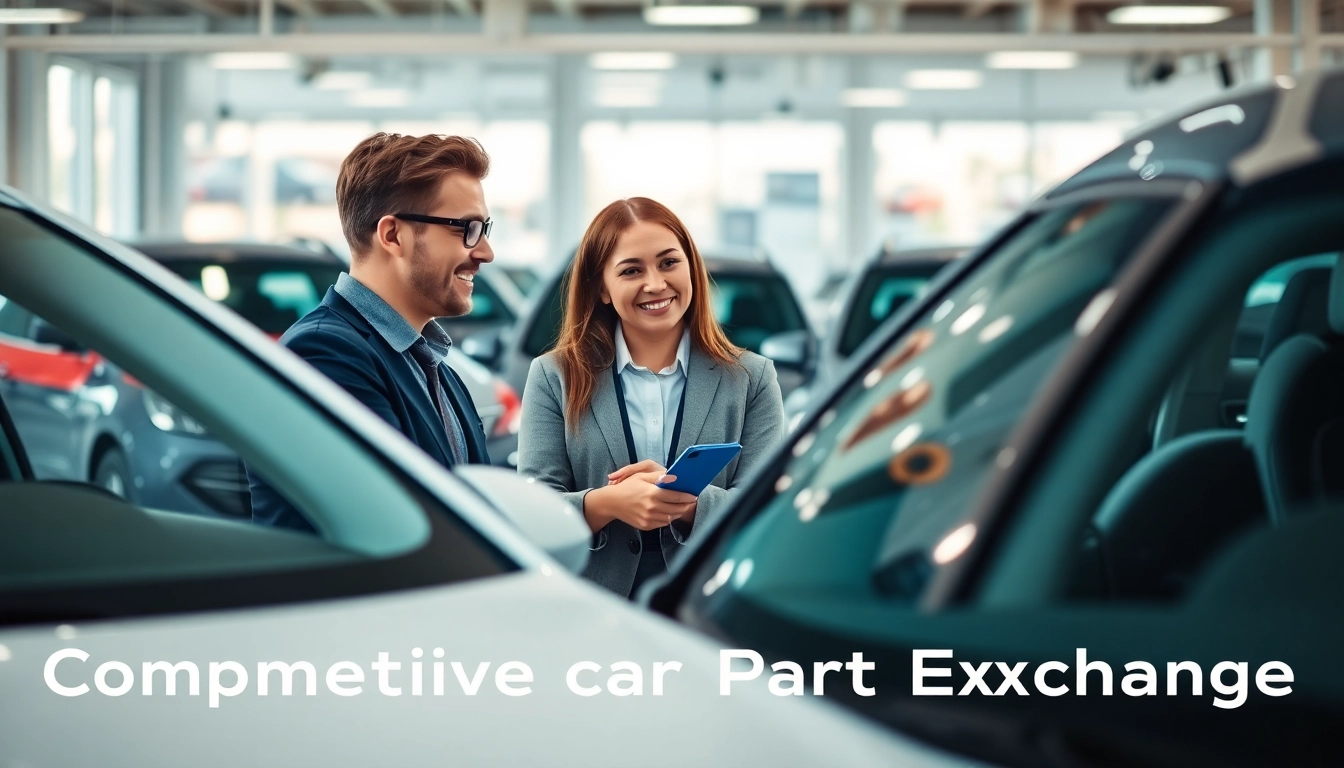Understanding Competitive Car Part Exchange
The concept of Competitive car Part Exchange has gained significant traction as a preferred method for upgrading to a new vehicle. This strategy involves trading in your existing car as a part of the down payment towards a new purchase. As the automotive market evolves, understanding the intricacies of part exchange becomes crucial for both new and seasoned car buyers. This article provides a comprehensive guide, exploring the benefits and processes involved in securing the best possible deal for your vehicle.
What is Car Part Exchange?
Car part exchange, commonly known as part exchanging, refers to the process where you trade your current vehicle in towards the purchase of another. This method simplifies the buying process, allowing car owners to direct the value of their old vehicle into a new one. The dealer assesses the value of your trade-in car and deducts that value from the price of the new vehicle you intend to purchase. Part exchange serves as a practical and time-efficient option, particularly for those looking to upgrade quickly and without the hassle of private sales.
Benefits of Choosing Part Exchange
There are multiple advantages to opting for part exchange rather than selling a car privately. Here are some key benefits:
- Convenience: Part exchanging is typically quicker and less stressful than trying to sell a car privately. The dealer handles most of the paperwork and logistics, making it hassle-free for the owner.
- Immediate Value: You receive an instant valuation for your vehicle, allowing you to apply that value directly to your new purchase, reducing the overall cost.
- Negotiation Leverage: Dealers often give competitive offers especially when faced with the competitive nature of the market, allowing room for negotiation beyond the initial offer.
- Trade-In Tax Benefits: Depending on your location, part exchange might allow you to save on tax by reducing the taxable amount of the new car purchase.
How Competitive Car Part Exchange Works
The part exchange process begins with the valuation of your vehicle. Here’s a step-by-step breakdown:
- Vehicle Inspection: You bring your vehicle to the dealership, where it undergoes an inspection to assess its condition, mileage, and overall functionality.
- Value Assessment: The dealer will provide a valuation based on various factors such as the current market trends, the condition of your vehicle, and demand for similar cars.
- Deal Negotiation: Once a valuation is established, you can enter negotiations regarding the offer. Different dealerships may provide varying offers, hence getting multiple valuations could benefit you.
- Agreement and Purchase: Upon agreeing to a fair value, the dealer deducts this amount from the price of your new car, finalizing the part exchange.
Evaluating Your Vehicle’s Worth
Understanding the value of your car is essential in the part exchange process. Accurately evaluating your vehicle ensures that you receive a fair offer.
Factors Influencing Car Value
Several factors influence the worth of your vehicle, including:
- Age and Mileage: Generally, newer cars with lower mileage are valued higher.
- Condition: The physical and mechanical state of your car, including the state of the interior, bodywork, and engine performance.
- Service History: A well-documented service history can greatly increase your car’s value, indicating reliability to potential buyers.
- Market Demand: Certain makes and models may be in higher demand, affecting their resale value positively.
Researching Market Prices
Before initiating the part exchange process, conduct thorough market research to gauge how much similar vehicles are being sold for. Websites such as AutoTrader, Edmunds, and Kelley Blue Book offer valuable tools and resources to check the current value of your car.
Common Mistakes to Avoid in Valuation
A few pitfalls can diminish the potential value of your car:
- Overestimating Condition: Avoid inflating your car’s condition; honesty is critical as issues will be discovered during inspection.
- Neglecting Market Data: Ignoring current market trends can lead to misleading expectations regarding your vehicle’s worth.
- Rushing the Process: Take your time to get multiple quotes to ensure you are getting the best possible deal.
Navigating the Part Exchange Process
The part exchange procedure now demystified, let’s delve into how to navigate this journey effectively.
Steps to Initiate a Competitive Car Part Exchange
Embarking on the part exchange journey involves several steps:
- Understand Your Needs: Determine what type of vehicle you need and how much you can afford after trade-in.
- Get Your Car Ready: Clean and maintain your vehicle to the best of your ability. Address minor repairs that could affect its value.
- Contact Dealerships: Reach out to multiple dealerships to get preliminary values and see what offers they can provide.
- Schedule Appointments: Arrange time at different dealerships to have your car evaluated and receive offers.
Preparing Your Vehicle for Trade-In
Presenting your vehicle in the best possible condition maximizes its value during evaluation. Key preparation steps include:
- Detailing: Have your car professionally cleaned inside and out. A clean vehicle appears more attractive and can dramatically increase perceived value.
- Maintenance Records: Gather all maintenance records and documentation to provide transparency to potential buyers.
- Minor Repairs: If feasible, fix minor issues that might detract from the car’s value, such as tire replacements or scratch repairs.
Negotiation Tactics for Better Offers
Negotiation is a critical component of securing the best deal. Use these tactics to improve your bargaining position:
- Research Comparable Values: Come to negotiations armed with data on what similar vehicles are worth.
- Be Firm but Fair: Present your findings while being respectful towards the dealer. A well-reasoned argument backed by research can go a long way.
- Be Prepared to Walk Away: Indicate that you’re willing to explore other offers if the deal isn’t satisfactory; this can motivate dealers to enhance their offers.
Comparing Part Exchange to Other Selling Options
Potential sellers often weigh their part exchange options against other methods of divesting their vehicles. Let’s explore these comparisons.
Private Sale vs. Part Exchange
While private sales can yield higher prices, they can also involve more time, effort, and uncertainty. Here are pros and cons to help you decide:
- Private Sale: Potential for a significantly higher return; however, this method requires more time and involves dealing with negotiations and potential complications.
- Part Exchange: Quick and straightforward process that avoids the hassle, but amounts might be lower than what you could garner in a private sale.
Understanding Trade-In Value
Understanding the concept of trade-in value is essential for anyone considering part exchange. The trade-in value is the amount a dealer is willing to credit you for your old vehicle when you purchase a new one. It’s crucial to align your expectations accordingly.
Identifying the Right Selling Strategy
Choosing the correct selling strategy largely depends on your personal circumstances, including:
- Time Constraints: If you are in a hurry to acquire a new vehicle, part exchange is the more fitting option.
- Market Demand: Consider the current demand and how it influences your vehicle’s saleability in a private market versus trading it in.
- Emotional Attachment: For many, letting go of a vehicle can be an emotional process. Part exchange offers a smoother transition.
Maximizing Your Returns
Once you’ve decided to move forward with a part exchange, maximizing your returns is paramount. Here’s how you can do that:
Timing Your Exchange for Best Value
Timing can significantly impact the value of your trade-in. Some strategies include:
- Market Trends: Monitor car sales data and evaluate the best time of year when demand typically peaks.
- New Model Releases: Consider trading in just before the release of new models, as dealers may be more willing to offer competitive rates due to increased demand.
- Seasonal Factors: Certain types of vehicles are more desirable in specific seasons (e.g., convertibles in summer). Aligning your exchange accordingly can be beneficial.
Sealing the Deal: Final Steps in the Process
Once you’re satisfied with an offer, ensure that the final steps safeguard your interests:
- Review the Agreement: Carefully read through the purchase agreement and prune any inconsistencies or surprising terms.
- Understand the Payment Structure: Confirm how the part exchange will affect the overall financing of the new vehicle.
- Cancel Insurance and Transfer Registration: Make sure to follow through on any insurance cancellations or vehicle registration transfers as needed.
Tips for Post-Transaction Satisfaction
Finally, to ensure overall satisfaction post-transaction, consider the following:
- Feedback: Don’t hesitate to give feedback to the dealer regarding your experience, which can assist in future negotiations for yourself or others.
- Post-Purchase Inspection: After purchasing your new vehicle, ensure it’s thoroughly inspected and verify its condition matches your understanding before finalizing the sale.
- Stay Informed: Keep abreast of market value changes; knowing how to navigate the market can help in future trade-ins.

